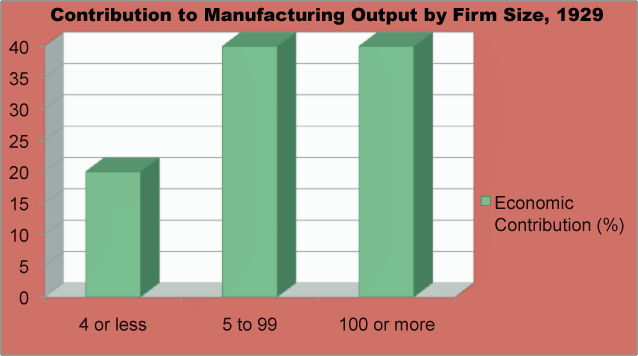
Family owned
Close ties to government
Mitsui
Mitsubishi
Sumitomo
Yasuda
Iwasaki Yataro, 1835-85
Farming family
Tosa financial manager, 1865
*Crony capitalism?
Tosa assets and debts, 1870
11 steamships and other enterprises
Meiji steamships, 1874-5
Nagasaki Shipyard, 1883
Dry goods stores, 1800s
Supplied Tokugawa armies
*Crony capitalism?
Collected public tax revenues, 1868-82
Miike coal mine, 1888
Mitsui Bank
Loans to govt officials, 1870s-80s
Tomioka Silk Reeling Factory, 1893
Based on the cartoon, what is the popular view of the big businesspeople in Japan?
Based on the chart below, what was the relative importance of small businesses and Zaibatsu in Japan's economic development?

Based on Fumiko's memoir and this photo, how did consumers make purchases in Japan's towns and cities? How did this differ from the traveling peddlers in Kobayashi’s village?
Boom and bust economy
6.15% average growth/year
9% average growth/year during WWI
Munitions, heavy equipment, and chemicals to Allies
Textiles to Asian markets
Inflation
1918 rice riots
3.34% average growth/year
Increased international competition

Based on this photo and Fumiko’s life in the countryside, what were living conditions like in rural Japan?

*Yawata Ironworks, 1901
Diet approves, 1894
Significance of date?
Opens, 1901
1/3 of domestic production, 1911
Unprofitable
Privately-owned ironworks (zaibatsu)
Supplied 1/4 of domestic demand, 1913
Japanese steel production, 1913
Output 1/100 of US, 1913
Without colonies Japan's comparative advantage is in textiles
Individualism
Stylish “modern girls” striding briskly along the streets of Tokyo in 1930 (Gordon, p. 162). How do the moga represent a trend among some youth to adopt individualism over the traditional collective values?
Socialists
Communists
Peace Preservation Law, 1925
Censorship
Bans groups against national polity and private property
Cities
Exports fell 50%,
Countryside
Silk cocoon price
1925-29, 30% drop
1929-31, 30% drop
Who is in power in the cabinets at this time?
Prime Minister represented political party
*Inukai Tsuyoshi assassinated May 15, 1932
Average of 9 out of 12 cabinet ministers from parties
No Prime Minister was a party politician
Average of 3 out of 13 cabinet ministers from parties